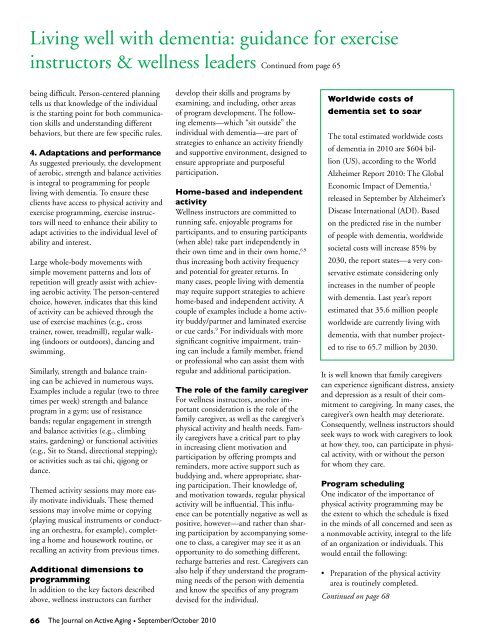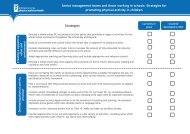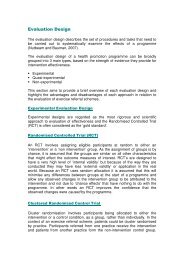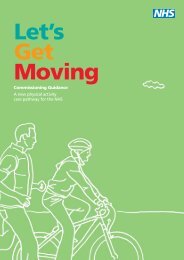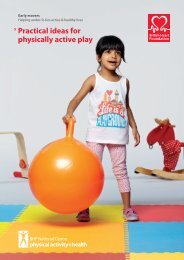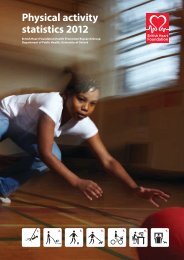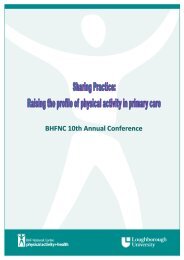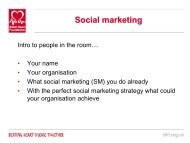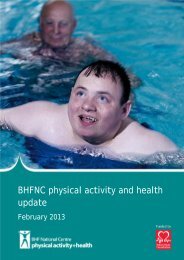Living well with dementia: guidance for exercise ... - Vida Wellness
Living well with dementia: guidance for exercise ... - Vida Wellness
Living well with dementia: guidance for exercise ... - Vida Wellness
- No tags were found...
Create successful ePaper yourself
Turn your PDF publications into a flip-book with our unique Google optimized e-Paper software.
<strong>Living</strong> <strong>well</strong> <strong>with</strong> <strong>dementia</strong>: <strong>guidance</strong> <strong>for</strong> <strong>exercise</strong>instructors & <strong>well</strong>ness leaders Continued from page 65being difficult. Person-centered planningtells us that knowledge of the individualis the starting point <strong>for</strong> both communicationskills and understanding differentbehaviors, but there are few specific rules.4. Adaptations and per<strong>for</strong>manceAs suggested previously, the developmentof aerobic, strength and balance activitiesis integral to programming <strong>for</strong> peopleliving <strong>with</strong> <strong>dementia</strong>. To ensure theseclients have access to physical activity and<strong>exercise</strong> programming, <strong>exercise</strong> instructorswill need to enhance their ability toadapt activities to the individual level ofability and interest.Large whole-body movements <strong>with</strong>simple movement patterns and lots ofrepetition will greatly assist <strong>with</strong> achievingaerobic activity. The person-centeredchoice, however, indicates that this kindof activity can be achieved through theuse of <strong>exercise</strong> machines (e.g., crosstrainer, rower, treadmill), regular walking(indoors or outdoors), dancing andswimming.Similarly, strength and balance trainingcan be achieved in numerous ways.Examples include a regular (two to threetimes per week) strength and balanceprogram in a gym; use of resistancebands; regular engagement in strengthand balance activities (e.g., climbingstairs, gardening) or functional activities(e.g., Sit to Stand, directional stepping);or activities such as tai chi, qigong ordance.Themed activity sessions may more easilymotivate individuals. These themedsessions may involve mime or copying(playing musical instruments or conductingan orchestra, <strong>for</strong> example), completinga home and housework routine, orrecalling an activity from previous times.Additional dimensions toprogrammingIn addition to the key factors describedabove, <strong>well</strong>ness instructors can furtherdevelop their skills and programs byexamining, and including, other areasof program development. The followingelements—which “sit outside” theindividual <strong>with</strong> <strong>dementia</strong>—are part ofstrategies to enhance an activity friendlyand supportive environment, designed toensure appropriate and purposefulparticipation.Home-based and independentactivity<strong>Wellness</strong> instructors are committed torunning safe, enjoyable programs <strong>for</strong>participants, and to ensuring participants(when able) take part independently intheir own time and in their own home, 6,9thus increasing both activity frequencyand potential <strong>for</strong> greater returns. Inmany cases, people living <strong>with</strong> <strong>dementia</strong>may require support strategies to achievehome-based and independent activity. Acouple of examples include a home activitybuddy/partner and laminated <strong>exercise</strong>or cue cards. 9 For individuals <strong>with</strong> moresignificant cognitive impairment, trainingcan include a family member, friendor professional who can assist them <strong>with</strong>regular and additional participation.The role of the family caregiverFor <strong>well</strong>ness instructors, another importantconsideration is the role of thefamily caregiver, as <strong>well</strong> as the caregiver’sphysical activity and health needs. Familycaregivers have a critical part to playin increasing client motivation andparticipation by offering prompts andreminders, more active support such asbuddying and, where appropriate, sharingparticipation. Their knowledge of,and motivation towards, regular physicalactivity will be influential. This influencecan be potentially negative as <strong>well</strong> aspositive, however—and rather than sharingparticipation by accompanying someoneto class, a caregiver may see it as anopportunity to do something different,recharge batteries and rest. Caregivers canalso help if they understand the programmingneeds of the person <strong>with</strong> <strong>dementia</strong>and know the specifics of any programdevised <strong>for</strong> the individual.Worldwide costs of<strong>dementia</strong> set to soarThe total estimated worldwide costsof <strong>dementia</strong> in 2010 are $604 billion(US), according to the WorldAlzheimer Report 2010: The GlobalEconomic Impact of Dementia, 1released in September by Alzheimer’sDisease International (ADI). Basedon the predicted rise in the numberof people <strong>with</strong> <strong>dementia</strong>, worldwidesocietal costs will increase 85% by2030, the report states—a very conservativeestimate considering onlyincreases in the number of people<strong>with</strong> <strong>dementia</strong>. Last year’s reportestimated that 35.6 million peopleworldwide are currently living <strong>with</strong><strong>dementia</strong>, <strong>with</strong> that number projectedto rise to 65.7 million by 2030.It is <strong>well</strong> known that family caregiverscan experience significant distress, anxietyand depression as a result of their commitmentto caregiving. In many cases, thecaregiver’s own health may deteriorate.Consequently, <strong>well</strong>ness instructors shouldseek ways to work <strong>with</strong> caregivers to lookat how they, too, can participate in physicalactivity, <strong>with</strong> or <strong>with</strong>out the person<strong>for</strong> whom they care.Program schedulingOne indicator of the importance ofphysical activity programming may bethe extent to which the schedule is fixedin the minds of all concerned and seen asa nonmovable activity, integral to the lifeof an organization or individuals. Thiswould entail the following:• Preparation of the physical activityarea is routinely completed.Continued on page 6866The Journal on Active Aging • September/October 2010


